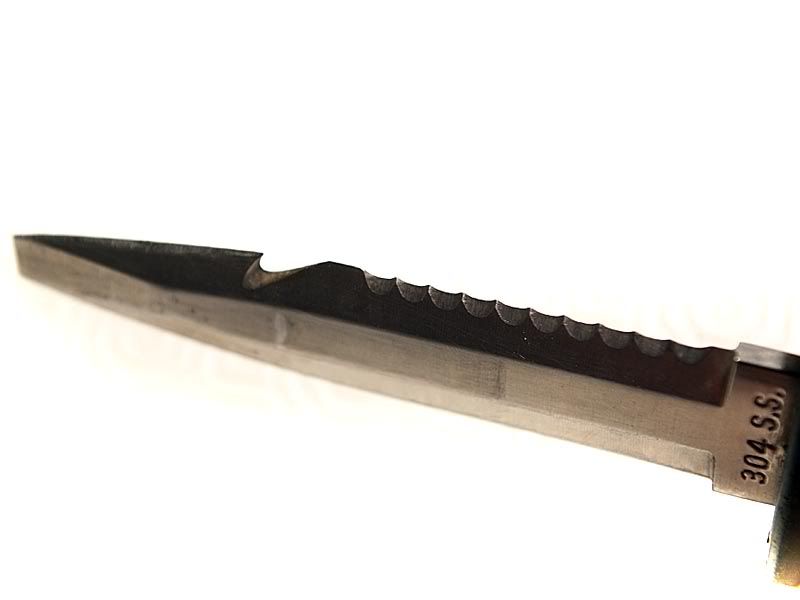
So it was with interest that I unwrapped the Typhoon offering and inspected it. It’s not a small knife so isn’t one that would be fixed to a buoyancy aid chest attachment point, measuring as it does 26cm sheathed; nor is it lightweight, weighing in at around 270 grammes. A lot of this weight comes from the pommel, which is weighted for use as a hammer and is also handy for dispatching fish cleanly, a task which it did well and which removes the need to carry another tool to do this job.

Also designed into the handle is a lanyard hole. This is important and means that the knife can be used either with a leash or, my preferred method, with a wrist loop. This gives additional security against loss over the side as the knife isn’t designed to float. It also helps for me as I have my knife tucked down inside my knee-length paddling boots and thus I can pull the loop to bring the knife up to where I can take hold of the handle. The handle itself is shaped and contoured to allow a firm grip and being of high-impact plastic is easy to clean and maintain.

The knife comes with sheath straps to allow fitment to the calf as with all dive knives however this puts the knife in the perfect position to get caught up on things on a kayak so these were immediately put aside. The sheath itself is of high-impact plastic and the knife sits in place, locked by a button on the handle. I have yet to have the knife come out on its own accord so the system works although the sheath itself is quite bulky for a knife of this size and the fit is quite sloppy with the knife rattling a bit at times.

The blade is made from grade 304 18/8 stainless steel which has excellent corrosion resistance and is therefore very suitable for the marine environment. Once properly sharpened it will hold its edge well…but when it’s gone it is very difficult to re-sharpen properly with an edge that will last. A blade with a higher carbon content, although less resistant to corrosion, is easier to sharpen and will take and hold a better edge but unfortunately the aesthetics of a rust-free knife are deemed more important in the diving world as they are not intended for constant use.

The blade design incorporated four points that are of interest to kayak anglers. From the business end, the first is a blunt-nosed chisel tip. This can be used for removing shellfish (such as limpets etc) from rocks when bait collecting but more importantly for us means it has less chance of puncturing the kayak, clothing or skin of the user than if the tip was pointed. The downside comes when wanting to gut a fish in the standard manner of slicing from the anal vent towards the head. Typhoon also make a similar version with a pointed end so the choice is down to personal preference.

The next feature is the mesh cutter notch ground into the top of the blade. This allows the user to pull downwards onto a cord in order to exert direct pressure on a specific point which reduces the possibility of slipping along the length of the cord. It works, and works well with cords of low diameter. For larger diameter lines the serrated edge running along the spine would be the tool of choice. This is used in a sawing motion and is capable of cutting through medium diameter lines that are difficult to cut with a plain edge or the mesh cutter and also has a use for cutting through bone on fish without blunting the main edge. The length of the serrated edge is not that great however, due largely to the inclusion of the hook, so some effort would be required sawing through a thicker piece of rope but it is still better than having a straight edge only.

The main edge itself runs almost the full length of the blade and was sharp enough for general use when it came out of the box. It remained sharp for a few trips but when I finally managed to wear the edge down through use I tried sharpening it. I tried a chef’s steel, a carborundum stone and my kitchen sharpener (two steels crossed). None of these gave me a satisfactory edge that lasted even with a fair bit of effort and, not wanting to use a grinder (the heat damages the strength of the edge) I gave up. This was very disappointing as a knife that is difficult to sharpen doesn’t tend to get sharpened which is the reason I haven’t used this knife in months. Overall I felt that, due to this, the knife fulfilled the (large) safety knife role well but was not suitable for my use as a general purpose fishing knife.
Thumbs up guys your doing a truly terrific job. rescue knife
ReplyDelete